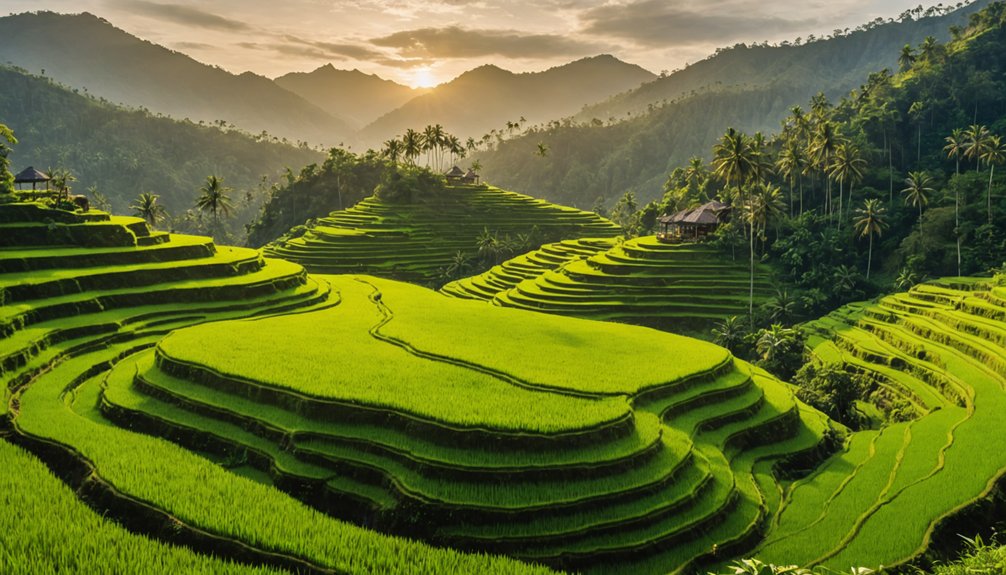The best time to visit Indonesia is during the dry season from April to October, when you’ll enjoy sunny skies and comfortable temperatures between 25-30°C. This period offers ideal conditions for diving, trekking, and exploring ancient temples across the archipelago. While July and August mark peak tourist season, you’ll find better deals and fewer crowds during shoulder months like May, June, and September. Each of Indonesia’s diverse islands holds unique seasonal treasures waiting to be discovered.
Key Takeaways
- May to October offers dry weather with ideal conditions for outdoor activities, diving, and mountain trekking across most Indonesian islands.
- Peak tourist season runs June to August and December/January, featuring vibrant festivities but larger crowds and higher prices.
- March to June and September to November are shoulder seasons with fewer tourists and discounted rates up to 50%.
- Western regions like Sumatra and Java experience heaviest rainfall November to March, while eastern islands are driest June to September.
- Year-round temperatures remain consistent between 25-30°C, making Indonesia accessible in any season with proper planning.
Weather Patterns & Seasonal Changes
Indonesia’s tropical climate follows a predictable rhythm with two distinct seasons that’ll shape your travel experience. The dry season runs from April through October, while the wet season dominates from November to March, with temperatures staying consistently warm between 25°C-30°C year-round.
Rainfall dynamics vary dramatically across the archipelago. You’ll encounter heavier precipitation in western regions like Sumatra and Java, where cities like Bogor experience over 300 thunderstorm days annually. Meanwhile, eastern areas like Komodo remain considerably drier, receiving minimal rainfall during peak dry months. These patterns are driven by monsoon winds that sweep across the nation. The temperature typically drops 1°C per 90 meters as you ascend in elevation.
Microclimatic factors create unique conditions in different zones. Highland areas offer cooler temperatures around 23°C, while coastal regions maintain steady warmth at 28°C. The Maluku Islands feature their own distinct weather patterns, influenced by localized wind currents that create unpredictable rainfall throughout the year.
Peak Tourist Seasons Vs Off-Peak Benefits
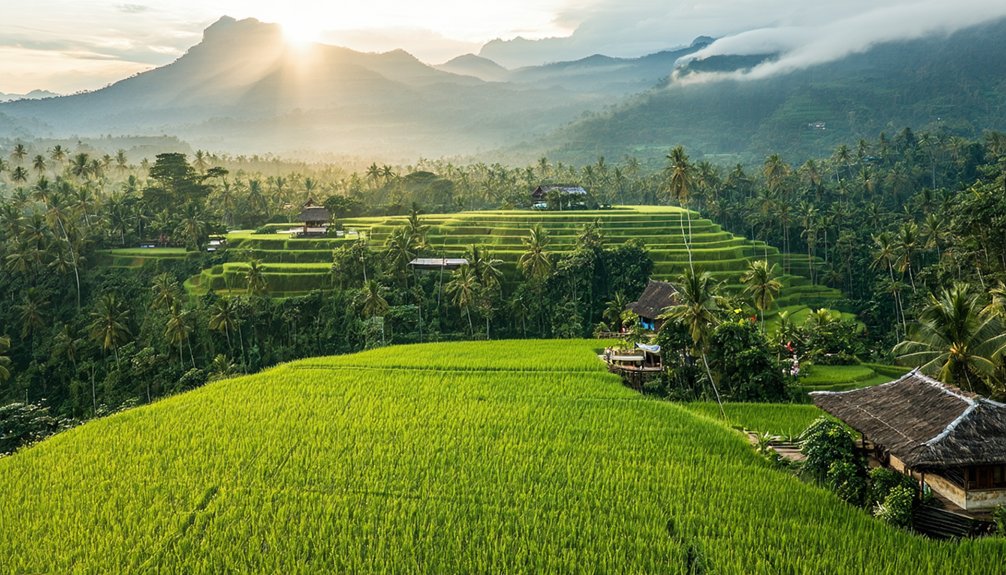
While savvy travelers can find enjoyment year-round, Indonesia’s peak tourist seasons bring both opportunities and challenges you’ll want to ponder. From June through August and during the Christmas/New Year period, you’ll encounter vibrant energy and bustling festivities, but also substantial crowds at major attractions, with popular beach destinations seeing up to 60% more visitors. The dry sunny weather from May to October provides ideal conditions for outdoor activities and beach vacations.
If you’re seeking a more budget-friendly experience, consider traveling during off-peak periods. You’ll find accommodation discounts of up to 50% compared to peak rates, allowing you to stretch your travel budget further. Beyond the financial benefits, off-peak travel offers unique advantages for authentic local community engagement. You’ll have more opportunities to interact with residents, participate in cultural activities, and explore popular sites without the usual tourist crowds. This quieter atmosphere lets you discover Indonesia’s treasures at your own pace, creating more intimate and meaningful experiences throughout your journey.
Regional Weather Variations Across Islands
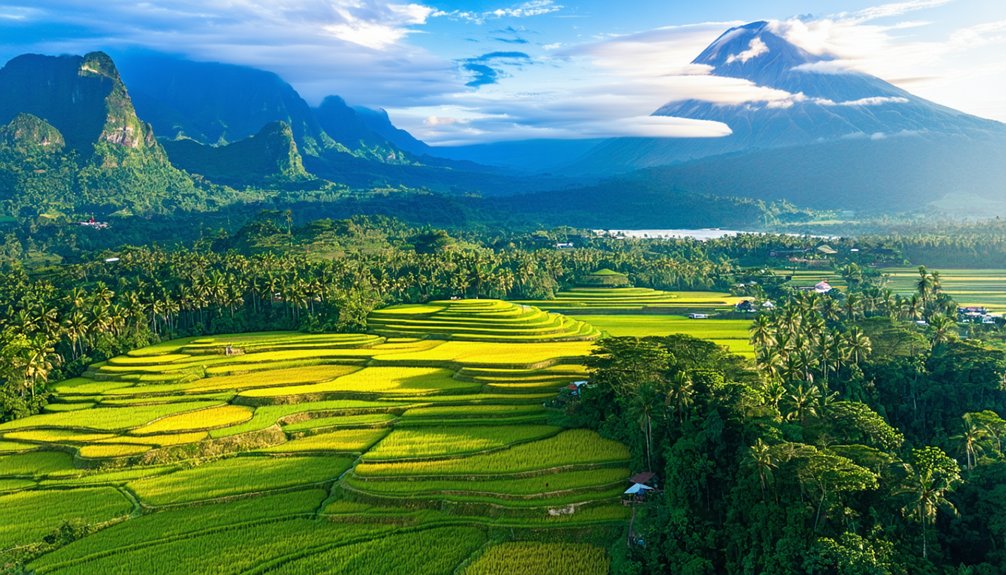
Five distinct climate zones across Indonesia’s vast archipelago create a fascinating weather tapestry you’ll need to ponder when planning your visit. The western islands of Sumatra, Java, and Bali embrace you with lush, humid conditions and abundant rainfall exceeding 2,000mm annually, while the eastern reaches of Nusa Tenggara offer a dramatically different experience with their drier, Australian-influenced climate.
Sulawesi’s unique microclimatic variations showcase the archipelago’s complexity, where you’ll find northern regions dancing to their own weather patterns, while Papua presents an equatorial paradise in its lowlands and invigoratingly cool highlands. The mountainous regions provide ideal conditions for diverse ecosystems with their cooler alpine temperatures. You’ll discover localized weather anomalies throughout, from Bogor’s frequent thunderstorms to Raja Ampat’s steady tropical warmth.
When plotting your Indonesian adventure, remember that timing is everything – western regions peak in rainfall from November to March, while eastern islands experience their driest spell from June through September.
Cultural Festivals & Local Celebrations
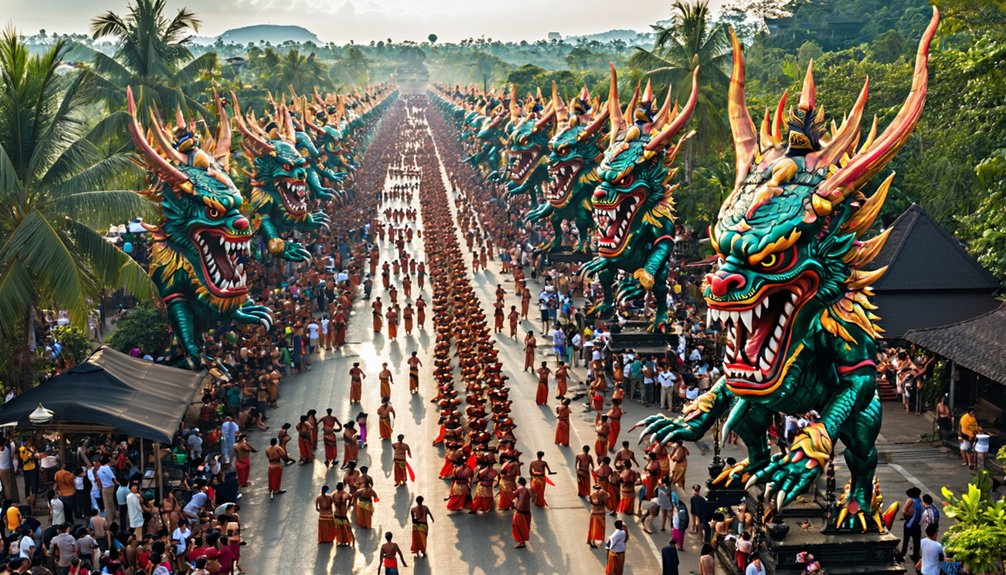
A vibrant tapestry of cultural celebrations unfolds throughout Indonesia’s calendar year, offering you an extraordinary window into the nation’s diverse spiritual and artistic heritage. From the ethereal silence of Bali’s Nyepi to the thundering hooves of Makepung buffalo races, you’ll discover folklore traditions that have endured for generations. Traditional Chinese communities celebrate Cap Go Meh feast with elaborate processions and feasts marking the final day of Lunar New Year festivities.
If you’re drawn to spiritual experiences, plan your visit around Waisak at Borobudur Temple or witness the dramatic Yadnya Kasada offerings at Mount Bromo. For cultural heritage preservation in action, don’t miss the Jember Fashion Carnival or Solo Batik Carnival, where traditional artistry meets contemporary expression. The Torajan Rambu Solo and Sundanese Seren Taun offer profound insights into Indonesia’s ancient harvest rituals.
Modern celebrations like the Java Jazz Festival and Ubud Writers Festival showcase Indonesia’s evolving cultural landscape, while regional events like Erau Festival and Dieng Culture Festival maintain their authentic local character.
Diving & Marine Activities Calendar
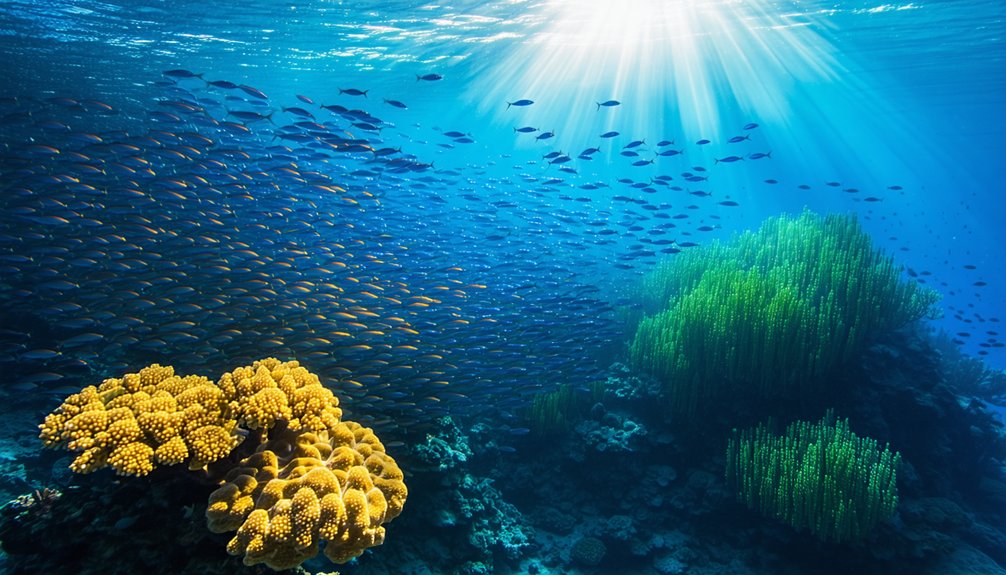
Indonesia’s marine landscape transforms dramatically throughout the year, with each region offering its own prime underwater season. You’ll find pristine conditions in Raja Ampat from October to April, while Komodo National Park shines with exceptional 30-meter visibility from June through September. For the best marine life encounters, time your visit with the manta rays in Raja Ampat (October-April), whale sharks in Cenderawasih Bay (August-October), or the spectacular coral spawning events in Komodo during September. The Banda Sea offers divers some of its most remarkable experiences during March to December, with its thriving reefs and diverse marine ecosystems.
Regional Peak Diving Seasons
While Indonesia offers year-round diving opportunities, each region’s prime underwater season follows distinct patterns tied to monsoon cycles and marine migration. For ideal conditions, head to Bali and Nusa Islands from April to November when visibility peaks at 40 meters, with manta ray sightings year-round and Mola Mola appearances in July-August. With over 3,000 species inhabiting its waters, Indonesia’s marine biodiversity is unmatched in the world.
Komodo National Park shines from April to November with clear waters perfect for shark encounters, while Raja Ampat’s sweet spot runs October through April with exceptional 30-meter visibility. The region’s warm waters, consistently between 26-30°C, make diving comfortable throughout the year. Plan your visit during shoulder seasons (April-June, September-November) to enjoy fewer crowds and better rates, especially if you’re eyeing popular spots like Bunaken or Misool.
Marine Life Migration Patterns
Beyond the ideal diving seasons, understanding marine life migrations helps you time encounters with Indonesia’s most spectacular species. The archipelago’s rich marine corridors host spawning aggregations and feeding hotspots that attract diverse megafauna throughout the year.
Key seasonal highlights for marine encounters:
- December-March: Reef mantas in Komodo and pregnant females at Nusa Penida’s cleaning stations
- July-November: Blue whales passing through Savu Sea following krill blooms
- August-November: Oceanic mantas gathering in Raja Ampat’s Dampier Strait
- April-June: Massive tuna schools entering Flores Sea for spawning
The dry season from May through September offers the best visibility for underwater photography and marine life spotting. You’ll find whale sharks year-round in Cenderawasih Bay, while sea turtle encounters peak during nesting seasons – primarily November through April in the Derawan Islands for green turtles, and December through August for leatherbacks in Papua.
Trekking & Adventure Activities Timeline
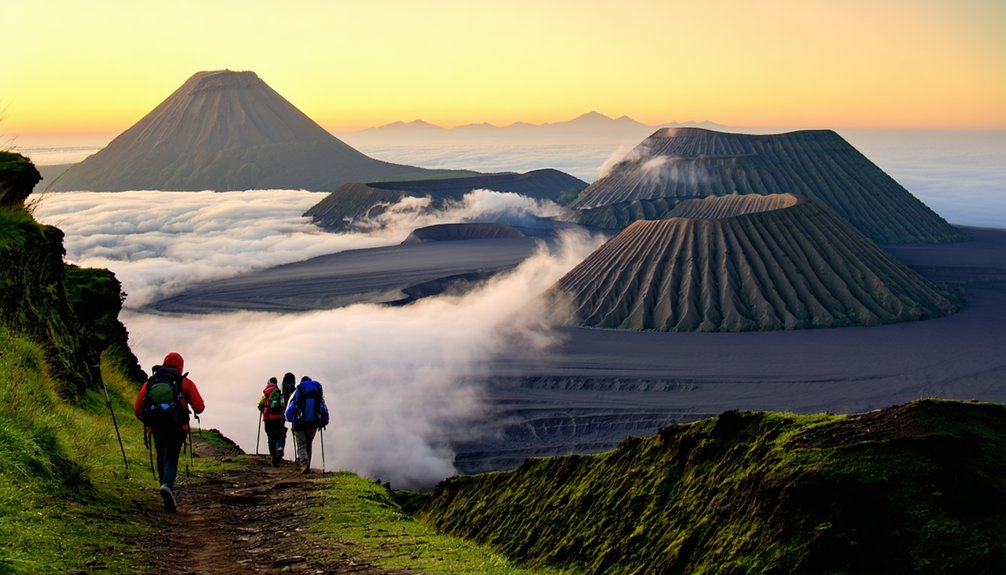
The diverse landscapes of Indonesia offer year-round adventure opportunities, but timing your trek or outdoor activity can make or break your experience. You’ll find favorable mountain climbing difficulty during the dry season (April-October), when trails are stable and visibility is excellent. During this period, you’re looking at peak trekking safety precautions with minimal rainfall risks. The season rewards adventurers with clear summit views throughout the day.
For the adventurous spirit, shoulder seasons (March-June and September-November) present unique opportunities. You’ll encounter fewer tourists on popular routes while still enjoying relatively stable conditions. However, watch out for the haze in Sumatra and Kalimantan from September to November.
If you’re heading east, Papua’s Carstensz Pyramid welcomes technical climbers from April to November, while Mount Rinjani in Lombok’s best hiking window runs April through October. Got diving in mind? Raja Ampat‘s crystal-clear waters offer spectacular visibility between June and August, with depths reaching an impressive 30 meters.
Budget-Friendly Travel Periods
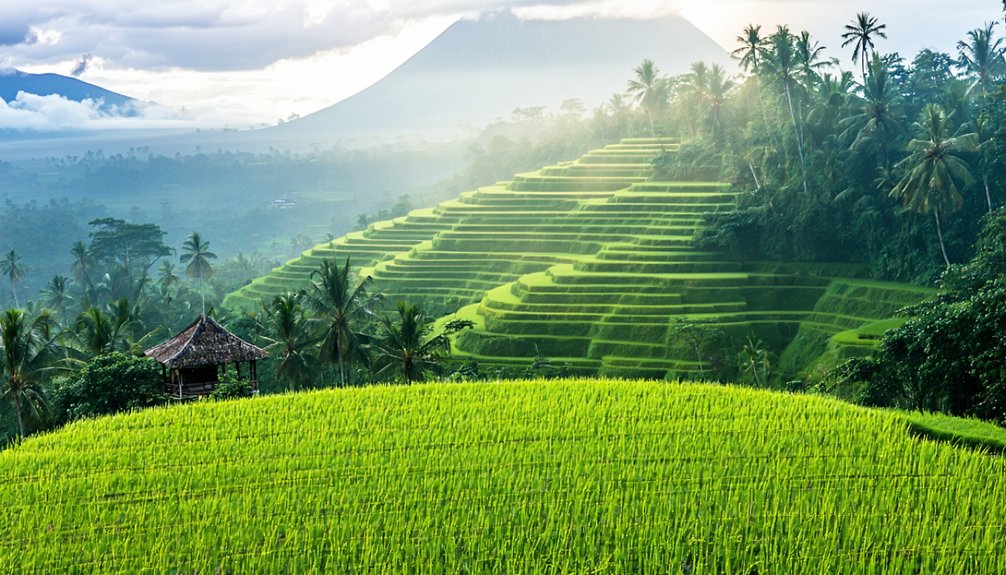
Since savvy travelers understand the value of timing, Indonesia’s low season from October to April presents incredible opportunities for budget-conscious adventurers. You’ll find substantial transportation discounts on domestic flights and extensive savings on accommodations, with rates slashed up to 50% compared to peak times. During this period, you can expect to experience frequent rain showers but consistently warm temperatures.
Plan your Indonesian adventure during low season to slash costs in half while enjoying crowd-free experiences across the archipelago.
For maximum savings during your Indonesian journey, consider these money-saving periods:
- November-March: Score hotel deals up to 30% off while exploring local culinary experiences
- April-May: Enjoy mild weather with budget rooms starting at $2/night
- September-October: Take advantage of promotional deals on tours and activities
- Off-peak months: Find Jakarta-Bali flights from $40 one-way
The shoulder seasons offer an ideal balance of affordability and comfort. You’ll discover less crowded cultural sites in Java, peaceful beaches in Bali, and authentic experiences in Sumatra – all while keeping your wallet happy. Just avoid the Christmas/New Year weeks when prices rise dramatically.
Island-Specific Travel Windows
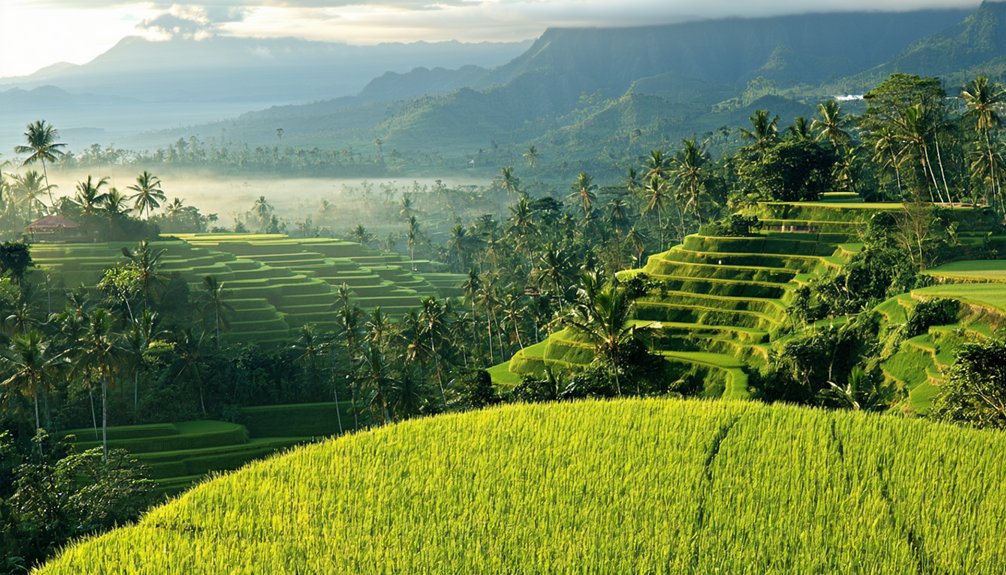
You’ll discover Bali’s prime travel sweet spot during July and August, when cloudless skies and gentle breezes create perfect conditions for both beach lounging and cultural excursions. In Sulawesi, the July-September window offers exceptional marine visibility at Bunaken park, while the southern highlands of Toraja showcase their best trekking conditions. Java’s ancient temples and volcanic landscapes shine brightest from May through September, when clear skies and dry conditions make exploration of sites like Borobudur and Mount Bromo most rewarding. Travelers can find better deals and fewer crowds during the shoulder season months of May, June, and September.
Bali’s Perfect Travel Months
Choosing perfect months to visit Bali comes down to three distinct travel windows, each offering unique experiences for different types of travelers. May through September delivers pristine conditions for outdoor adventures, wildlife encounters, and culinary experiences, with June being particularly ideal for beating the crowds while enjoying sunny skies.
Travelers can expect temperatures between 26-29°C year-round, making any season viable for a visit.
For the best blend of value and experience, target these prime periods:
- May-June: Ideal weather, fewer tourists, moderate prices
- September: Post-peak serenity with ideal diving conditions
- November-December: Lush landscapes, dramatic surfing, major discounts
- February: Ultimate solitude, though pack rain gear
You’ll find excellent diving visibility from April through October, while November brings spectacular west coast waves for surfers. The island’s consistent warmth means you’re free to plan around your preferred activities and budget rather than temperature concerns.
Sulawesi Diving Calendar
Beneath Sulawesi’s crystal-clear waters lies a year-round diving paradise, but timing your visit can make all the difference. You’ll find ideal water conditions from May to October, with July and August delivering peak visibility of up to 30 meters and comfortable temperatures around 27-30°C.
Each region offers its own sweet spot: North Sulawesi shines from April to November, while the South beckons from May to November. If you’re heading to Wakatobi Marine Park, plan for May through September when seasonal currents are gentlest. Lembeh Strait’s famous muck diving stays spectacular year-round, though waters cool slightly during the dry season. For the ultimate experience, target July through September when manta rays and whale sharks make regular appearances, drawn by nutrient-rich plankton blooms. Shoulder season visitors in late March and April can still enjoy excellent diving conditions with the added benefit of smaller crowds.
Java Temple Season
While Java’s ancient temples stand as eternal monuments, timing your visit is essential for the ideal experience. You’ll find the most reliable conditions for sunrise/sunset photography opportunities during the dry season from May to October, when clear skies create favorable lighting conditions for temple photography. The September to March season offers particularly spectacular views of cultural traditions and rainforest backdrops.
For the best temple experience, consider these key timing strategies:
- Book sunrise tours (5:30 AM) at Borobudur for crowd-free shots
- Visit during May-June or September to avoid peak season crowds
- Leverage shoulder-season discounts on guided tours (15-20% savings)
- Plan around full moon events, which require advance booking
The sweet spot is August, with less than 10% chance of rainfall and perfect visibility of volcanic backdrops. You’ll enjoy temperatures between 24-32°C, ideal for exploring temple complexes without the monsoon season’s challenges.
Traditional Ceremonies & Religious Events
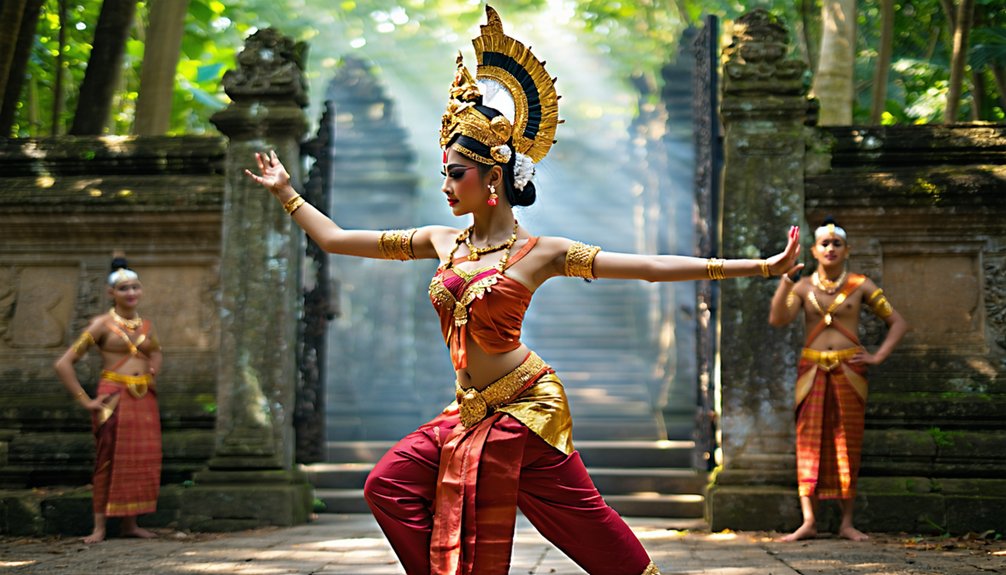
Throughout Indonesia’s vibrant cultural landscape, you’ll discover a rich tapestry of religious ceremonies and traditional events that transform any ordinary visit into an extraordinary cultural journey. From Bali’s mesmerizing Nyepi Day of Silence to the nationwide celebrations of Eid al-Fitr, each festival offers unique faith-based experiences that’ll enrich your understanding of this diverse archipelago.
You can immerse yourself in Hindu-Balinese traditions during the 10-day Galungan festival, where decorated bamboo poles line the streets, or join Buddhist pilgrims at Borobudur for the illuminating Waisak ceremony. During Saraswati celebrations, visitors can witness how children bring offerings to their school temples in a beautiful display of cultural devotion. For cultural immersion opportunities, don’t miss the vibrant Islamic celebrations of Eid al-Fitr in May or the spirited regional events like the Bali Spirit Festival. Just remember to check the lunar calendar carefully, as many religious dates shift annually, and consider the seasonal timing – the dry season from May to September typically offers the most favorable conditions for outdoor ceremonies.

